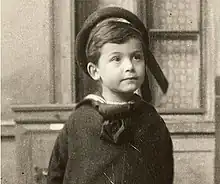
John von Neumann as a child
In psychology research literature, the term child prodigy is defined as a person under the age of ten who produces meaningful output in some domain to the level of an adult expert professional.[1][2][3]
Mathematics and science
Mathematics
- Blaise Pascal (1623–1662) was a French mathematician, physicist, and religious philosopher who wrote a treatise on vibrating bodies at the age of nine; he wrote his first proof, on a wall with a piece of coal, at the age of 11 years, and a theorem by the age of 16 years. He is famous for Pascal's theorem and many other contributions in mathematics, philosophy, and physics.[4]
- John Stuart Mill (1806–1873) was a British philosopher and economist. At the age of eight, Mill began studying Latin, the works of Euclid, and algebra. At about the age of twelve, Mill began a thorough study of the scholastic logic. In the following year he was introduced to political economy and studied Adam Smith and David Ricardo.
- Norbert Wiener (1894–1964) was an American philosopher and mathematician. He graduated from Ayer High School at 11 years of age. He was awarded a BA in mathematics in 1909 at the age of 14.
- Lev Landau (1908–1968) was a Soviet physicist who mastered calculus by age 13. He graduated from the Baku Gymnasium aged only 13 as well. Landau is today best known for his work in superconductivity and a series of textbooks he co-authored with Evgeny Lifshitz.
- John von Neumann (1903–1957) was a "mental calculator" by the age of six years, who could tell jokes in classical Greek.[5][6] Von Neumann went on to make numerous contributions to mathematics, economics, physics, and computer science. (Note: Several mathematicians were mental calculators when they were still children. Mental calculation is not to be confused with mathematics. This section is for child prodigies largely or primarily known for calculating skills.)
The arts
Music
Literature
- William Cullen Bryant published his first poem at the age of 10; at the age of 13 years, he published a book of political satire poems.[7]
- Minou Drouet caught the notice of French critics at the age of eight, leading to speculation that her mother was the true author of her poetry. She later proved herself to be the author.[8]
Visual arts
- Edmund Thomas Clint (1976–1983) was an Indian child prodigy.[9] He is known for having drawn over 25,000 paintings, though he lived to be just six years and 11 months old.[10]
Games
Chess
See Chess prodigy for details of child prodigies at chess.
Go
- Sumire Nakamura was competing in national Go tournaments in Japan by the time she was seven, and became the youngest professional go player at age 10 in 2019.[11][12]
Other
Some children become famous and are called a prodigy although it is questionable whether they have produced meaningful output to the level of an adult expert professional.[13]
- Arden Hayes (born 2008) who as a five-year old appeared in newspapers and television shows because of his ability to memorize information about certain topics.[14]
See also
References
- ↑ Feldman, David H.; Morelock, M. J. (2011). "Prodigies". In Runco, Mark A.; Pritzker, Steven R. (eds.). Encyclopedia of Creativity. Encyclopedia of Creativity (Second Edition). Academic Press. pp. 261–265. doi:10.1016/B978-0-12-375038-9.00182-5. ISBN 978-0-12-375038-9.
For the purposes of this and future research, a prodigy was defined as a child younger than 10 years of age who has reached the level of a highly trained professional in a demanding area of endeavor.
- ↑ Rose, Lacey (2 March 2007). "Whiz Kids". Forbes. Archived from the original on 22 October 2020. Retrieved 3 April 2015.
At the moment, the most widely accepted definition is a child, typically under the age of 10, who has mastered a challenging skill at the level of an adult professional.
- ↑ Feldman, David Henry (Fall 1993). "Child prodigies: A distinctive form of giftedness" (PDF). Gifted Child Quarterly. 27 (4): 188–193. doi:10.1177/001698629303700408. ISSN 0016-9862. S2CID 144180264. Archived (PDF) from the original on 13 January 2016. Retrieved 1 June 2014.
- ↑ William Durant; Ariel Durant (1963). The Age of Louis XIV: A History of European Civilization in the Period of Pascal, Molière, Cromwell, Milton, Peter the Great, Newton, and Spinoza: 1648-1715. Simon and Schuster. p. 56.
- ↑ "Von_Neumann summary". st-and.ac.uk. Archived from the original on 31 December 2015. Retrieved 18 December 2015.
- ↑ "The History of Computing". gmu.edu. Archived from the original on 11 December 2015. Retrieved 18 December 2015.
- ↑ "On William Cullen Bryant". vcu.edu. Archived from the original on 18 December 2015. Retrieved 18 December 2015.
- ↑ "Kitten on the Keys", (archived page) Time Magazine Jan 28, 1957.
- ↑ "The unfading colours of child prodigy". The Hindu. 18 August 2006. Archived from the original on 23 October 2007. Retrieved 18 December 2015.
- ↑ "The Hindu : She spells hope and happiness". hinduonnet.com. Archived from the original on 6 June 2011. Retrieved 18 December 2015.
{{cite web}}: CS1 maint: unfit URL (link) - ↑ "Japanese girl to be youngest Go professional". BBC News. 6 January 2019. Archived from the original on 4 July 2019. Retrieved 25 September 2020.
- ↑ "Youngest professional Go player aged 10 marks debut with loss". 23 April 2019 – via Mainichi Daily News.
- ↑ "Is Your Child REALLY a Genius?". Pittsburgh Parent. 8 November 2019. Retrieved 12 August 2023.
- ↑ Lelyveld, Nita (4 May 2013). "This presidential database loves running and Legos". Los Angeles Times. Retrieved 12 August 2023.
This article is issued from Wikipedia. The text is licensed under Creative Commons - Attribution - Sharealike. Additional terms may apply for the media files.